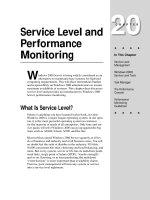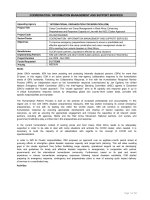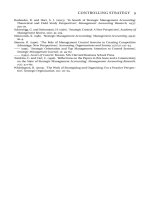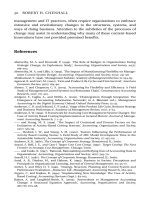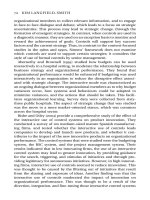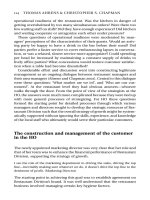Controlling Strategy Management and Performance Measurement_7 pptx
Bạn đang xem bản rút gọn của tài liệu. Xem và tải ngay bản đầy đủ của tài liệu tại đây (611.31 KB, 21 trang )
operational readiness of the restaurant. Was the kitchen in danger of
getting overwhelmed by too many simultaneous orders? Were there too
few waiting staff on shift? Did they have enough experience? Did kitchen
and waiting cooperate or antagonize each other under pressure?
These questions of operational readiness were moderated by man-
agers’ perceptions of the characteristics of their guests. Would an arriv-
ing party be happy to have a drink in the bar before their meal? Did
parties prefer a faster service to cover embarrassing lapses in conversa-
tion, or was a relaxed, slower service more appropriate? Could spending
per head be increased by maintaining a constant supply of drinks to
lively office parties? What concessions would restore customer satisfac-
tion when a table had become dissatisfied?
Considerable effort and discussion went into constructing legitimate
management as an ongoing dialogue between restaurant managers and
their area managers (Ahrens and Chapman 2002).Centraltothisdialogue
were these questions: ‘What market are we in?’, and ‘Who are our cus-
tomers?’. At the restaurant level they had obvious answers—whoever
walks through the door. From the point of view of the strategists at the
HO, the answers were much more complicated because they were tied up
with more general processes of strategizing. For HO these questions
formed the starting point for detailed processes through which various
managers and directors sought to develop the strategic resources of Res-
taurant Division such that the o verall strategy of growth might be system-
atically supported without ignoring the skills, experience, and knowledge
of the local staff who ultimately would serve their particular customers.
The construction and management of the customer
in the HO
The newly appointed marketing director was very clear that her role and
that of her team was to enhance the financial performance of Restaurant
Division, supporting the strategy of growth.
I see the role of the marketing department in driving the sales, driving the top
line—inevitably making sure whatever we do, it doesn’t drive the top line to the
detriment of profit. (Marketing Director)
The starting point in achieving this goal was to establish agreement on
Restaurant Division’s brand. It was well understood that the restaurant
business involved managing certain key hygiene factors.
114 THOMAS AHRENS & CHRISTOPHER S. CHAPMAN
Any piece of market research will tell you customer wants high standards, safe,
clean. (HR Director)
Long-term success, however, depended on the development of a dis-
tinctive brand.
The brand’s important at the moment because it gives the customer a certain
minimum standard and a reassurance of what they’re gonna get when they go
through the door. (Regional General Manager)
. . . you come into a [Restaurant Division restaurant], you feel, immediately the
anxiety is de-stressed from you by the way that we’re going to deal with you as
you come through the door. And you sit down and you get an informal, quality
meal, which is our brand position. We’re not there yet, that’s the big task for next
year. (Marketing Director)
But beyond being ‘relaxing’, ‘informal’, ‘accommodating’, and
‘friendly’, what should be key to the vision of Restaurant Division’s
brand image? There was agreement amongst senior management that
without a more distinctive customer proposition Restaurant Division’s
growth strategy would be difficult to achieve.
I mean we are perceived as an undifferentiated brand in an undifferentiated
market. So, you know, I mean you could ask anybody what we were about
[laughs] they wouldn’t answer in a line. I couldn’t find anything, in any docu-
ment I read, I couldn’t find a succinct line. I could find a mission statement
which was . . . I think it was ‘[to be] the first choice in every local area for a proper
restaurant.’ [ . . . ] but we don’t have anything that’s consumer orientated at all.
(Marketing Director)
The marketing director’s frustration with the mission statement was
driven by the fundamental problem of aligning strategic and operational
management. Howcould she harnesstheefforts oflocalmanagerswithout
a brand vision that was more clearly related to the day-to-day manage-
ment of restaurants? And how could she do so without stifling restaurant
managers’ desire to contribute their specific knowledge and experience?
The mission statement as it stood struck a balance that placed the em-
phasis firmly at the local level. ‘How to make each individual restaurant
first choice in its own area’ opened up a very large range of equally valid
actions, and the mission statement itself provided little guidance for
choosing between alternatives. In the eyes of the marketing director the
brand value of informality was convenient for an organization with res-
taurants all over the country, but it did not offer a coherent concept.
For a chain organization, the absence of some central theme to the
mission was particularly vexing because it undermined the potential
MCS AND THE CRAFTING OF STRATEGY 115
advantages that Restaurant Division could derive from its size. How
exactly were HO’s considerable conceptual and technical resources to
be deployed for the practical ta sks of addressing and attracting new and
repeat customers?
So on the one hand we, we’ve got to retain a national identity to get the benefit
out of things like TV advertising, but at the same time research is telling us that
people want it to be less formal as a brand, in other words, more informal
and with more local taste, so there’ll be certain elements of the brand that
are fixed and they tend to be the things you can’t touch really. (Operations
Director)
Despite this trend towards the fle xible and less uniform, the marketing
director was at pains to point out that developing the brand concept and
then fostering appropriate local actions required a significant analytical
effort at the HO. She related the processes of strategic analysis and
communication to key financial and non-financial information. Such
information was a central plank in developing a sense of accountability
for the actions of her subordinates and herself.
I want [my marketing analyst’s work] to be measurable, I want to be able to turn
round at the end of every piece of activity and say ‘this has worked or it hasn’t
worked and this is why.’ And you can’t do that if you don’t set yourself proper
objectives in the first place. (Marketing Director)
[Corporate head office executive] said to me yesterday ‘Okay, Judy, if I gave you a
million pounds can you do some marketing activity which would give me two
million pounds?’ And I had to say, ‘No I can’t.’ Now I’d like to be able to turn
round and say, ‘Yes I can, and it’s this, and this is why I know’—and I can’t.
So I find that frustrating. (Marketing Director)
But as well as fostering a greater sense of accountability the marketing
team clearly felt that better management information would play a vital
role in developing practical lines of action to support the divisional
strategy. For exampl e, it might help decide which groups of existing
customers and non-users to target with what kinds of one-off or long-
term discount schemes, as well as which categories of restaurants to
earmark for different kinds of refurbishment and alterations.
I think you’ve got to clearly define who you’re targeting towards and you, you can
either target people who are currently going in there [the restaurants], but they
know you anyway and are turning up, so the cost effectiveness of that would be
questionable [ . . . ] Or you can target people who, who have maybe not any
perception of what you’re about. But if you do that you’ve got to give them a
reason to turn up, a reason to re-evaluate, and a reason to say, well, why didn’t
116 THOMAS AHRENS & CHRISTOPHER S. CHAPMAN
you go somewhere else. And that’s the trick in getting that mix right basically.
(Marketing Analyst)
You know, nineteen per cent of our family users never go back. They’ve got the
[family discount] card, [but] never go back in because they haven’t got [an outlet]
near them, ‘cos they’ve been travelling or whatever. And so we were just giving
away discount on them and, and you know it should be an incentive for people
to come back again. (Marketing Director)
[Better information would] enable me to understand what percentage of our
market would be using it how often. And [ . . . ] if it’s easier to get people moving
from two to four [restaurant visits per year], or is it easier for some people to
move from four to eight? And I don’t know that. Then I could say, ‘All right, well,
the easiest to get my first slot of activity would be to get people to move from
four to six visits a year, right.’ Well, I can mail them and I know that a mailing is
going to cost me 48 pence. I know their names and addresses and I can target my
offer to them, ‘cos I know they like this, um, I can say, you know, ‘If you spend ten
pounds you get this,’ you know. I can do all sorts. (Marketing Director)
I’d like to have some more segmentation by [restaurant], so, you know, I’d like to
be saying with all the restaurants with gardens in summer, which ones aren’t
performing? Of those where we’ve just done refurbishment, which ones aren’t and
which ones are, which ones doweneedto do activity and which ones don’t need to
do activity. And I’d like the regional marketing manager to take responsibility for
being able to be proactive and analysing the information. (Marketing Director)
What connected those ideas for the management of marketing activity
was that they relied on strategic uses of financial and non-financial
management information.
The marketing director regarded more detailed management infor-
mation as absolutely essential to her work. She felt that restaurant
managers based their judgements all too often on ‘anecdotal’ informa-
tion and might be dismissive of requests she might make of them to
systematically collect more reliable information. Nevertheless, she and
other senior HO managers were keen to avoid constructing analytical
models of restaurant operations that sought to simply overwrite local
knowledge and conditions.
I see next year very much about national activity [ . . . ] establishing what the
brand is about, which is run by my trial group [ . . . ] and then underneath we’ve
got, and quite down near the bottom we’ve got a whole load of local activity,
which is the manager knowing his area, knowing the garages, knowing the
schools, knowing the cubs,
1
knowing the scouts, and building from the local
information base around his [restaurant], direct mail, um, doing local promo-
1
Junior scouts.
MCS AND THE CRAFTING OF STRATEGY 117
tions with local papers, um, and then tailoring his outlook much more to a local
community. And that’s in terms of how the [restaurant] looks and in terms of
what he actually does. (Marketing Director)
On the brand positioning? [ . ] it’s being led by our marketing department. I’ve
got two of my area managers sitting on the working parties ‘cos their areas will
be in the trial for it, so they will have some influence on what goes into that in the
detailed stuff rather than the directional stuff. The directional stuff is coming
from the marketing department supported by the board. The detailed stuff’s
coming into the sub-working parties which will have operational representatives
on, and assistant people on and HR people on, to try and give it real flesh around
the bones. (Regional General Manager)
In relation to the brand value of informality the operations director
explained how this process of giving it ‘real flesh’, or introducing it to
specific restaurant contexts, worked in relation to a particular aspect of
service standards for waiting staff.
We have a thing called a check-back, in other wordswithin twominutes a waitress
has to check-back with the customer on the main course: ‘Is everything all right,
Sir?’ That will be measured if the mystery diner goes in. Now that, that is a good
example of formality, so you and I could be talking like this, obviously we’re happy
because we’re talking and she’ll come up, interrupt you . Now what we really
want them to do is to just look and observe, and you can, if you and I sat there like
this, you know [leans forward, frowns], she, she, she’ll know there’s an issue,
assuming it’s not an argument. But if you say that to a waitress ‘Well you know,
show your own judgement,’ so what you’re actually doing is looking to catch my
eye and going, ‘Okay?’ before long, because we’ve got ten thousand people in our
business, it’s becoming that when two guys come in in a suit, obviously talking
about business, you don’t need to check-back. And that is the challenge. How do
we not lose all that good work . . . Very difficult and I don’t know the answer other
than through education. And of course everybody will say, ‘Well that’s easy. It’s
obvious’. But in reality, I promise you now, it won’t be long before that’s what
would happen: You don’t need to check-back if it’s two guys in a suit [ . ] The way
we build up all these things is to involve waitresses, managers. Umpteen people
now have been put together in groups to describe how best we do it [ . . . ] There’s
got to be some system but at the same time it’s not got to appear as formal as you
[as a customer] feel like you’re being processed. (Operations Director)
Discussion
In Restaurant Division, MCS informed various processes of strategizing.
To achieve the targets for its strategy of growth, the marketing director
118 THOMAS AHRENS & CHRISTOPHER S. CHAPMAN
sought to develop an initially undifferentiated brand concept in ways
that would enable her to harness the efforts of individual restaurant
managers for specific HO initiatives, each one of which would be tar-
geted at specific strategic objectives. For exampl e, with respect to the
management of customers, she systematically segmented customers
into groups with specific consumption profiles for whom particular
offerings, membership cards, and other incentive schemes were
designed to increase customer spending. Spending increase was ana-
lysed as a combination of repeat custom and spending per visit. This
allowed not only for the evaluation of operational management but also
generated information that could be used to refine the customer pro-
files. With respect to the management of restaurants she categorized
them acco rding to the facilities that they offered to customers and the
revenue effects of different kinds of enhanceme nts to those facilities.
From a marketing point of view MCS was thus central to enabling the
marketing department to work towards Restaurant Division’s strategy of
growth through small measurable steps. In this way, the growth strategy
could be related to specific marketing activities intended to link to
patterned but not predetermined local activity in restaurants. The strat-
egy of trying to be the ‘first c hoice in every local area’, left the marketing
team initially frustrated because it simply sought to leave the local local,
and did not provide a brief for HO marketing. It gave no direction for
action. The tailoring of local offerings in terms of service or marketing
incentives was regarded as important, but it was also acknowledged that
it ought to be based on some core strategic proposition without, im-
portantly, simply replacing local efforts with central instructions. The
examples of the working parties on brand positioning and the check-
back initiative showed the perceived advantages of seeking to develop
service elements jointly between the HO and restaurants in order to
achieve the desired effects on restaurant operations.
Herein, we believe, lies an important contribution of a practice per-
spective on MCS and strategy. Traditionally, management control stud-
ies have highlighted the problems arising from local resistance to HO
strategies, or contrasted HO with grass-roots strategies. Vaivio (1999 )
for example, emphasized the initially disciplining effects of central
financial and non-financial management information on local sales
managers and the subsequent reinterpretation of that information in
an emerging sales discourse that placed local over central insights.
By contrast, a practice perspective makes visible the potential for
management control information to become tied up in a productive
local–central interaction. Strategy formulation becomes a process that
MCS AND THE CRAFTING OF STRATEGY 119
reckons with local resistance (de Certeau 1988). Management control
information offers a way of not only gauging the effects of different
strategic designs but also pursuing different degrees of flexibility
enjoyed by restaurants that operate within that overall design (Ahrens
and Chapman 2004a).
Our analysis of managers in Restaurant Division recognized that
strategy as an encompassing organizational phenomenon ultimately
comes to life in the actions of individual managers (Ortner 1984),
which would suggest that management control as a practice is far
from the exclusive domain of accountants. In this chapter we sought
to explore the ways in which HO marketing staff and various managers
from the operations hierarchy sought to draw on performance informa-
tion in their efforts to draw together diverse facts, aspirations, and
routine actions in the construction of Restaurant Division’s strategy.
Managers throughout the organization sought to distribute the cogni-
tive processes of strategy formation across the organization rather than
centralize them at the HO (Lave 1988). The processes of management
control—the collection of information for mapping organizational ac-
tion as well as the dissemination of performance information—formed
one of the ways in which they sought to bring about this ‘distribution-
across’.
In this sense our analysis connects with process-oriented strategy
studies. What we seek to add is an und erstanding of how processes
of strategizing come to be constructed through MCS as well as non-
financial management information. For example, in terms of Restaurant
Division’s relationship with its customers, the strategic task lay as much
in customer selection and moulding as in identifying what the customer
wants. With the help of different kinds of management information the
process of strategizing became a process of discovering what the com-
pany wanted the customer to want and develop processes to deliver
according to those aspirations.
Our study of the practices surrounding the strategic uses of manage-
ment control information in Restaurant Division thus occupies a middle
ground between emphasizing the structuring powers of MCS and their
deconstruction into the actions of networks of individuals. Management
control as ‘action at a distance’ emphasizes its colonizing qualities,
the ways in which the uses of MCS are meant to reproduce centrally
conceived designs of operation across diverse locales (Robson 1992).
Actor-network theory, by contrast, emphasizes the constitution of man-
agement control and other organizational systems through networks of
individuals (and non-humans) (e.g. Briers and Chua 2001; Jones and
120 THOMAS AHRENS & CHRISTOPHER S. CHAPMAN
Dugdale 2002; Dechow and Mouritsen 2003; Quattrone and Hopper, In
Press). The shifting nature of those networks opens up the possibility of
deconstructing management control, through either change or disinte-
gration, because the networks tend to be characterized by a lack of
durable and overarching motives, such as the commercial motive in
the case of Restaurant Division. Our study emphasizes the ongoing
construction of the commercial motive through highly varied uses of
MCS. Rather than an instrument of power at a distance or the seed of
organizational deconstruction, MCS functioned as an interactive bridge
between diverse operational and strategic resources.
Conclusions
By focusing on the routines and practices surrounding the strategic uses
of performance information both in the HO and in restaurants we were
able to more clearly demonstrate the ways in which strategy and oper-
ational management interact. This relationship lies at the heart of what
makes the functioning of MCS so hard to under stand. It frequently
appears that all the finely designed ‘tie-ins’ between high-level strategic
planning and detailed opera tional control seem to disintegrate as soon
as a large organization tries to actually use its MCS. Complex manage-
ment control innovations that promised to ‘drill down’ corporate ob-
jectives into the last manufacturing cost centre and the farthest sales
district end up falling into disuse.
In the past, the response from the proponents of activity-based cost-
ing (ABC), the BSC, or Economic Value Added to critics of those systems
was simple: Use it more strategically! ABC becomes activity-based man-
agement. The BSC stops being a high-level perfor mance measurement
system for non-financial performance measures and becomes instead a
cornerstone of strategic management—as does Economic Value Added.
However, understanding the implications of such exhortations requires
a more detailed understanding of the ways in which MCS might support
the crafting of strategy (Mintzberg 1987).
In practice, the usefulness of MCS depends on whether managers
with sufficient experience of their organization and industry are given
the time to model the interdependencies between organizational pro-
cesses, strategic priorities, and financial outcomes. In our case organ-
ization we observed the ways in which this process of modelling became
a routine part of day-to-day management, spilling over into attempts to
MCS AND THE CRAFTING OF STRATEGY 121
engender the development of new ways of interacting with customers.
Performance information was to play a central role in shaping wide-
ranging discussions that drew together many interfunctional relation-
ships (Chapman 1998).
We saw, however, that performance information was not in and of
itself strategic, but opened up possibilities for managers to model the
business for themselves. The emphasis was not on MCS and techniques
as such but on the ways in which they were linked to operational and
strategic issues. This was because, apart from very simple and stable
situations, the conceptual linkages between organizational strategy and
operational action cannot rely on mechanical cause-and-effect relation-
ships. In competitive markets such relationships are short-lived.
For management control to function strategically it is best used as a
framing device, not an ‘answer machine’ (Burchell et al. 1980). Other-
wise strategy mapping may come to be mista ken for the organization’s
‘actual’ business model rather than a process that was meant to support
modelling the business. In this sense the criticisms that are often lev-
elled at MCS with strategic potential, such as the BSC or ABC, are
confusing the systems design with its use. When the causal maps on
which those systems are based are not updated, financial analysis easily
ossifies into a routine of its own, instead of engendering routines of
financial analysis for better understanding the organi zation.
References
Ahrens, T. (1997). ‘Strategic Interventions of Management Accountants: Everyday Practice
of British and German Brewers,’ European Accounting Review, 6(4): 557–88.
—— and Chapman, C. S. (2000). ‘Occupational Identity of Management Accountants in
Britain and Germany’, European Accounting Review, 9(4): 477–98.
—— —— (2002). ‘The Structuration of Legitimate Performance Measures and Manage-
ment: Day-to-day Contests of Accountability in a U.K. Restaurant Chain’, Management
Accounting Research, 13(2): 1–21.
—— —— (2004a). ‘Accounting for Flexibility and Efficiency: A Field Study of Manage-
ment Control Systems in a Restaurant Chain’, Contemporary Accounting Research,
21(2): 271–301.
—— —— (2004b, 5–6 June). ‘Management Accounting as Practice and Process’. Paper
presented at the Global Management Accounting Research Symposium, Lansing, MI.
—— and Dent, J. F. (1998). ‘Accounting and Organizations: Realizing the Richness of Field
Research’, Journal of Management Accounting Research, 10: 1–39.
Bourdieu, P. (1992). The Logic of Practice. Cambridge: Polity Press.
Briers, M. and Chua, W. F. (2001). ‘The Role of Actor Networks and Boundary Objects in
Management Accounting Change. A Field Study of an Implementation of Activity-Based
Costing’, Accounting, Organizations and Society, 26(3): 237–69.
122 THOMAS AHRENS & CHRISTOPHER S. CHAPMAN
Brown, S. and Eisenhardt, K. M. (1997). ‘The Art of Continuous Change: Linking Complexity
Theory and Time-Paced Evolution in Relentlessly Shifting Organizations’, Administrative
Science Quarterly, 42(1): 1–34.
Burchell, S., Clubb, C., Hopwood, A. G., Hughes, J., and Nahapiet, J. (1980). ‘The Roles of
Accounting in Organizations and Society’, Accounting, Organizations and Society, 5(1):
5–27.
Chapman, C. S. (1998). ‘Accountants in Organizational Networks’, Accounting, Organiza-
tions and Society, 23(8): 737–66.
Child, J. (1972). ‘Organizational Structure, Environment and Performance: The Role of
Strategic Choice’, Sociology, 6: 1–22.
de Certeau, M. (1988). The Practice of Everyday Life. Berkeley, CA: University of California
Press.
Dechow, N. and Mouritsen, J. (2003). ‘Enterprise Wide Resource Planning Systems and
the Quest for Integration and Management Control’. Paper presented at the Global
Management Accounting Research Symposium, Lansing, MI. www.bus.msu.edu/acc/
gmars/papers.html.
Dreyfus, H. and Dreyfus, S. (1988). Mind over Machine: The Power of Human Intuition and
Expertise in the Era of the Computer, 2nd edn. New York: Free Press.
Feldman, M. S. (2004). ‘Resources in Emerging Structures and Processes of Change’,
Organization Science, 15(3): 295–309.
Glaser, B. and Strauss, A. (1967). The Discovery of Grounded Theory: Strategies for Qualita-
tive Research. Chicago, IL: Aldine.
Guilding, C., Cravens, K. S., and Tayles, M. (2000). ‘An International Comparison of
Strategic Management Accounting Practices’, Management Accounting Research, 11(1):
113–35.
Johnson, G., Melin, L., and Whittington, R. (2003). ‘Guest Editors’ Introduction: Micro
Strategy and Strategizing: Towards an Activity-Based View’, Journal of Management
Studies, 40(1): 3–22.
Jones, T. C. and Dugdale, D. (2002). ‘The ABC Bandwagon and the Juggernaut of Modern-
ity’, Accounting, Organizations and Society, 27(1/2): 121–63.
Kaplan, R. S. and Norton, D. P. (1992). ‘The Balanced Scorecard—Measures that Drive
Performance’, Harvard Business Review (Jan.–Feb.): 71–79.
—— —— (1996). The Balanced Scorecard: Translating Strategy into Action. Boston, MA:
Harvard Business School Press.
—— —— (2000). ‘Having Trouble with Your Strategy? Then Map It’, Harvard Business
Review (Sept./Oct.): 167–77.
Lave, J. (1988). Cognition in Practice. Cambridge: Cambridge University Press.
Miles, M. and Huberman, A. (1994). Qualitative Data Analysis, 2nd edn. London and New
Delhi: Sage.
Mintzberg, H. (1987). ‘Crafting Strategy’, Harvard Business Review, 65(4): 66–75.
Mouritsen, J. (1999). ‘The Flexible Firm: Strategies for a Subcontractor’s Management
Control’, Accounting, Organizations and Society, 24(1): 31–
56.
Ortner, S. B. (1984). ‘Theory in Anthropology since the Sixties’, Comparative Studies in
Society and History, 26(1): 126–66.
Quattrone, P. and Hopper, T. ‘A ‘‘Time-Space Odyssey’’: Management Control Systems in
Two Multinational Organisations’, Accounting, Organizations and Society. (In Press.)
Roberts, J. (1990). ‘Strategy and Accounting in a U.K. Conglomerate’, Accounting, Organ-
izations and Society, 15: 107–26.
Robson, K. (1992). ‘Accounting Numbers as ‘‘Inscription’’: Action at a Distance and the
Development of Accounting’, Accounting, Organizations and Society, 17(7): 685–708.
Roslender, R. and Hart, S. J. (2003). ‘In Search of Strategic Management Accounting:
Theoretical and Field Study Perspectives’, Management Accounting Research, 14(3):
255–79.
MCS AND THE CRAFTING OF STRATEGY 123
Schatzki, T. R., Knorr Cetina, K., and von Savigny, E. (eds.) (2001). The Practice Turn in
Contemporary Theory. London and New York: Routledge.
Simmonds, K. (1981). ‘Strategic Management Accounting’, Management Accounting, 59( 4):
26–29.
—— (1982). ‘Strategic Management Accounting for Pricing: A Case Example’, Accounting
and Business Research, 47, 206–14.
Simons, R. (1990). ‘The Role of Management Control Systems in Creating Competitive
Advantage: New Perspectives’, Accounting, Organizations and Society, 15(1/2): 127–43.
—— (1995). Levers of Control. Boston, MA: Harvard Business School Press.
Strauss, A. and Corbin, L. (1990). Basics of Qualitative Research: Grounded Theory Proced-
ures and Techniques. London and New Delhi: Sage.
Tomkins, C. and Carr, C. (1996). ‘Reflections on the Papers in This Issue and a Commentary
on the State of Strategic Management Accounting’, Management Accounting Research,
7(2): 271–80.
Vaivio, J. (1999). ‘Examining ‘‘the Quantified Customer’’ ’, Accounting, Organizations and
Society, 24(8): 689–715.
Whittington, R. (2002). ‘The Practice Perspective on Strategy: Unifying and Developing a
Field’. Paper presented at the Academy of Management, Denver, CO.
124 THOMAS AHRENS & CHRISTOPHER S. CHAPMAN
Strategies and Organizational Problems:
Constructing Corporate Value
and Coherence in Balanced
Scorecard Processes
Allan Hansen and Jan Mouritsen
What is strategy? Management accounting researchers have often ig-
nored this question when they say that management accounting is for
implementing rather than formulating strategy. Inspired by Anthony’s
seminal work (1965), where management controls and strategic plan-
ning were separated, management accounting researchers have often
treated strategy as a ‘black box’. However, recent debates have paid more
attention to strategy. The debates in the 1990s, for example, emphasized
that the future of management accounting (e.g. Bromwich and Bhimani
1994; Ittner and Larcker 1998) is dependent on whether it can frame and
conceptualize strategic issues in organizations; to articulate strategy is a
way to regain the lost relevance of management accounting (Johnson
and Kaplan 1987). These thoughts have also been reflected in manage-
ment accounting innovations. In strategic cost management the value
chain (Shank and Govindarajan 1993), product attributes (Bromwich
1990), and customer functionality and quality (Cooper and Slagmulder
1997) have been mobilized and strategic performance measurements
systems take a point of departure in customers’ value proposition
(Kaplan and Norton 1996, 2001). Strategy is put forward in management
accounting in order to illuminate what corporate value and coherence is
about (e.g. Chenhall and Langfield-Smith 1998; Langfield-Smith 1997)
and management accounting is no longer neutral as Antho ny (1965)
suggested. Strategic management accounting is involved in mobilizing
objects and logic that seek to encapsulate what strategy is. Here man-
agement accounting enters a complex field because it has to navigate
between multiple, heterogeneous, and even competing representations
of what corporate value and coherence mean.
In this chapter we study processes of constructing corporate value
and coherence in organizational practices. Thus, we do not consider
corporate value and coherence to be pre-defined. On the contrary we
consider them to be phenomena that are constantly retranslated in
organizational practices. We contend that interpretations of corporate
value and coherence are ingredients in any strategy formulation and
consequently also in any strategic conceptualization in management
accounting. However, we also claim that the conceptualizations from
strategic management accounting might be challenged by what we call
organizational problems, which we see as situated manifestations of
pressures to act in organizational settings. Organizational problems
translate, and problematization ‘describes systems of alliances, or asso-
ciations between entities, thereby defining the identity and what they
‘‘want’’’(Callon 1986: 206).
1
We explore these issues through four firms’ mobilization of the bal-
anced scorecard (BSC). The BSC is a well-known example of strategic
management accounting in which ‘pre-made’ conceptualizations of
corporate value and coherence can be found. Even though Kaplan and
Norton (1996: 37–8) note that other conceptualizations of strategy may
be used, it is primarily the ‘Porterian’ framing of strategy (Porter 1980)
that lasts as the strategic conceptualization in the BSC (Kaplan and
Norton 1996: 37, 2001: 89). Thus, the ‘pre-made’ conceptualization of
strategy in the BSC is that first, environment and customers have to be
considered and understood, and then it is possible to develop internal
processes and investments in learning and growth activities. But when
firms mobilize the BSC, other conceptualizations of strategy may
emerge, and, as we will show, such othe r conceptualizations can be
found in organizational problems that are internal to the firm and
exist as local pressures act. This approach assumes that organizational
action exists prior to the work to dev elop strategy and that therefore
strategy is not before organizational action and problems but part of
organizational action and problems. Strategy is one of the operations of
organizational action. Thus, we suggest, like others, that strategic
management accounting should be studied in the context in which it
operates (Burchell et al. 1980; Hopwood 1983).
If strategy is one of the operations of ongoing organizational action,
the possible effects of a BSC probably are not only to implement a
strategy designed around Porter’s strategic opportunities. It is related
to the specific organizational problems that inform the design and
mobilization of the BSC. In our four cases we found that Porterian
1
We recognize that in this chapter all the facets of translations as described by Callon
(1986) have not been addressed. In addition to problematization he also discusses inter-
ressement, enrolment, and mobilization. We pay only scant attention to the three latter
processes in this chapter; however, we still have the possibility to illustrate the fluid
character of corporate value and coherence and consequently strategy in practical settings.
126 ALLAN HANSEN & JAN MOURITSEN
strategy was a weak element in the implementation of the BSC and
the strong elements were organizational problems such as planning
systems, cross-functional integration, internal benchmarking, and busi-
ness process reengineering (BPR). These problems framed the justifica-
tion of the BSC in the four firms—one in each of the firms. Planning,
cross-functional integration internal benchmarking, and reengineering
are ‘internal’ problems rather than market strategies. These internal
problems then coloured the mode in which value and coherence were
debated, and they thus framed the concerns labelled strategy.
We analyse how four firms brought the BSC into practice and discuss
what purposes and concerns it was related to. Our aim is not to examine
how strategy should have been formulated in relation to the BSC but
rather to analyse how the firms did discuss strategy. Some may suggest
that managers in the companies misunderstood what strategy and the
BSC were all about. We do not think so and we argue that stud ies of
processes of developing BSC can enlighten us about what strategy
formulation is as in practice. This persuades us that in our examples
concrete problems of internal production processes rather than notions
of the customer or the market facilitate the discussion of value and
coherence in the company, ending in propositions of strategy. This
does not imply that customers and markets were absent in the strategies
of the companies, but they were not the point of departure in formulat-
ing what value and coherence were to the companies. There was a way
from internal production issues to a strategy in the companies. This
way was developed in the four firms, and what seemed to be narrow
and particular or internal turned out to be inclusive and general.
Our exploration of BSC processes may add to our understanding of
what implementation of strategic management accounting is about. We
supplement studies of implementation, which have provided important
insight into the general factors at stake when implementing new man-
agement control and performance measurement systems (e.g. Ander-
son 1995; Shields 1995; Anderson and Young 1999; Cavalluzzo and Ittner
2004), showing how selection and interpretation of metrics, decision-
making authority, training, etc. affect their implementation. In contrast,
we attempt to conduct a ‘performative’ study where we focus on how
elements come into being and create the meaning of BSC in the specific
situations in which they are located. The objects for analysis are the
singular translation processes of value, coherence, and strategic man-
agement accounting/performance measurement (see also Preston et al.
1992; Chua 1995; Briers and Chua 2001). The analysis refrains from
seeing strategy as a black box and attempts to see and illuminate its
STRATEGIES AND ORGANIZATIONAL PROBLEMS 127
adoption to and fluidity compared with local conditions and concerns
(see also Roberts 1990; Miller and O’Leary 1993; Mouritsen 19 99).
Strategy and the BSC
Strategy has many faces (Mintzberg 1987; Mintzberg et al. 1998). Nume r-
ous dichotomies have been mobilized in order to cope with the com-
plexity of the concept. Is strategy a top–down or a bottom–up process
(Goold and Campbell 1987)? Is strategy emergent or deliberate (Min-
tzberg and Waters 1985)? Is strategy outside–in (Porter 1980) or inside–
out (Prahalad and Hamel 1990)? In this chapter we ask how strategies
require organizational problems to respond to and thus how strategies
get form and content. This may be an awkward discussion for those
blinded by the separation between formulation and implementation of
strategy. However, as we try to make sense of the four cases we present
hereafter, it appears to us that emergent strategy is part of (strategic)
management accounting because, seen as pr actice, strategy often starts
as a discussion of organizational problems, and (strategic) management
accounting is involved in developing and responding to organizational
problems. Kaplan and Norton’s conceptualization (2001: 89) of strategy
starts with ‘the value proposition [that] enables companies to define
their targeted customers’, which informs the selection of target cus-
tomers and a positioning of one self in the market. They (e.g. Kaplan
and Norton 2001: 75) draw on Porter’s conceptualization (1980) of strat-
egy so that a company ‘selects the value proposition at which it will
excel, a company also selects the customer segment or segments for
whom that value proposition will be the differentiator, causing them to
do business with the company. It is important to identify clearly the
company’s targeted customers’ (Kaplan and Norton 2001: 89). This is a
‘positioning perspective’ on strategy (Mintzberg 1987) and three generic
value propositions are possible: product leadership, customer intimacy,
and operational excellence (Treacy and Wiersema 1995). To Kaplan and
Norton, strategy is ‘a means of locating an organization in what organ-
isation theorists like to call an ‘‘environment’’ Strategy becomes a
‘‘niche’’, in economic terms, a place that generates ‘‘rent’’’ (Mintzberg
1987: 15).
The value proposition embedded in target customers represents an
outside–in logic as the value proposition is considered to ‘describe the
context’ (Kaplan and Norton 2001: 11) for the internal processes and
128 ALLAN HANSEN & JAN MOURITSEN
intangible assets within the company. The job of realizing strategy
becomes one of ‘ensuring alignment between an organization’s internal
activities and its customer value proposition’ (Kaplan and Norton 2001:
90). However, the outside–in logic may be challenged with an inside–out
logic (e.g. Johnson and Scholes 2002), where strategy begins by app oint-
ing internal competencies and routines (e.g. Prahalad and Hamel 1990;
Grant 1991). One might say that these challenges are symptoms of the
multiple and heterogeneous character of strategy which Kaplan and
Norton (1996: 38) seem to recognize implicitly, as they say—even if
they do not analyse how—that BSC may accommodate an ‘inside–out’
or other perspectives on strategy. All in all, these reopenings of the
strategy black box must intensify the call made by management ac-
countants for insight to the processes of construction of strategic issues
in practice; if there is no grand scheme of strategy or corporate value
and coherence what is it then that constitutes the ideas that prevail in
practice?
To study the implementation of BSC, we draw on a constructivist or
performative perspective on action (Latour 1986, Callon 1986), where
strategy—and corporate value and coherence—is constructed or per-
formed by actors. In this chapter we analyse the BSC as what Star and
Griesemer (1989: 393) call a boundary object: ‘Boundary objects are
objects which are both plastic enough to adapt to local needs and the
constraints of the several parties employing them, yet robust enough to
maintain a common identity across sites.’ The BSC is to us an open
concept, which can take a series of different forms, and yet it is also
robust (which we consider to be the distinction between non-finan cial
and financial numbers—leading and lagging indicators—organized and
balanced in several perspectives and with a relation to strategy imple-
mentation. There is, however, a considerable space for local adaptations
and innovations.
In our conceptualization of the construction of corp orate value and
coherence we draw on the notion of tran slation (Latour 1986, Callon
1986), and the significance of phenomena will be performed rather than
found in the phenomena themselves since ‘everything . . . is uncertain
and reversible, at least in principle. It is never given in the order of
things . . .’ (Law 1999: 4). Accordingly, the BSC is given content and iden-
tity via the relations it entertains with other entities in practice. This
theoretical position is one that tells that entities take their form and
acquire their attributes as ‘a result of their relations with other entities’
(Law 1999: 3, italics in original). In principle, any entity and relations can
play; they are heterogeneous rather than pure (Law 1999: 5), and it is not
STRATEGIES AND ORGANIZATIONAL PROBLEMS 129
possible a priori to point out the relations that will be decisive for
translations of corporate value and coherence. This approach contrasts
with other theories of strategic management accounting, which assume
that by definition we know what items such as strategy and performance
are a priori.
In this chapter we challenge whether strategy in relation to the BSC is
in fact (always) deliberate and builds on an outside–in logic. We sugge st
that realized strategy in relation to the BSC emerges from particular
organizational problems. The entities constituting strategy are different
from those suggested in strategic management accounting because the
notions of the market and the customer were distant in formulating the
objective of the BSC in our empirical situations. Rather, organizational
problems that developed over time in the firms constituted the interests
that BSC was to bend around. In effect, if this is true, this means that the
presumptions and articulations of strategy in much strategic manage-
ment accounting literature can be challenged. It may be that the an-
swers to the question of what strategy is are too institut ionalized in the
academic debate on strategy and management accounting and that new
possibilities of their relationships and practical constitution have to be
considered.
The cases
The four cases are all well known in the Danish debate on the BSC, and
they all used external consultants to help in their implementation. Table
4 summarizes understandings (translations) of corporate value and
coherence in the four companies. These particular translations were
formulated in fairly early stages of the implementation of the BSC in
companies. Other translations have emerged since but these early
stages hold interesting insights because propositions about what value
and coherence in respect to strategic performance measurement are
much debated in these stages. No particular translation was stabilized
or institutionalized. Things were in the process of becoming.
The table depicts the organizational problem related to the imple-
mentation of BSC in each company. This problem was the barrier to the
development of corporate value and coherence and was an input to
staging the concerns and just ifications about what the BSC was sup-
posed to achieve for the firms. The table also summarizes the role of
performance measurement in the firms.
130 ALLAN HANSEN & JAN MOURITSEN
Table 4 Corporate value, coherence, and strategic performance measurement in four cases
Company name ErcoPharm Kvadrat Columbus IT Partner BRFkredit
Industry Pharmaceuticals Textile IT Mortgage credit
Problem Corridor thinking—
suboptimization due
to functional orientation.
The solution is cross-
functional integration.
The innovative and
creative culture is a
barrier for growth.
Demand for a
planning culture.
Growth and heterogeneity
in the sales divisions
A need to standardize
the sales divisions.
Cost full and slow order
expedition within the
company—there is a
need to reengineer
certain processes
within the company.
Value
proposition
Cross-functional
integration
Planning Internal benchmarking Reengineering
The role of
performance
measurements
Performance
measurement accounts
for mutual dependency
between the functions.
Performance
measurement
initiates individual
goal setting
and planning.
Performance measurement
enables comparison of
process and performance
in different sales divisions.
Performance measure-
ment facilitates
control of reengineered
processes and possibility
to document success.
We may add that the customer was not absent in discussions related
to the BSC, but it was not the point of departure to propose what value
was to the firm or what corporate challenges were. Customers and
markets were mobilized as appendices to the central purposes of the
BSC in the firms, but only after organizational problems were addressed.
This makes strategic logic into something that is embedded in particular
organizational problems rather than in the target customer’s value
proposition, as suggested by Porter.
The cases illustrate how the BSC can be justified by entities other than
the customer and the market. A broad set of possible purposes is in place,
and the BSC is spacious enough to accommodate them all without losing
its appeal as a strategic management accounting system. We present the
cases as illustrations of four distinctly different/singular purposes in
each of the firms. This is clearly a simplification. In each of the firms
there were undoubtedly more propositions about the problems to be
negotiated and handled through the BSC as the firm’s problems could be
conceptualized differently—they were not fixed but negotiable.
This perspective that the BSC can be understood as an object with
many possible functions and effects has not been addressed much in
the literature. Literature on the BSC illustrates its possibility as a stra-
tegic management accounting system, either as a causal business model
or as a communication device. We suggest an addition, namely, to study
it as a boundary object (Star and Griesemer 1989) that is filled with
purpose and function as an effect of particular organizational problems
mobilized in the implementation process.
We learned about the four firms through visits and interviews with key
persons involved in BSC projects. The interviews were semi-structured,
lasted for about two hours, and dealt with questions related to strategy
formulation, the functionality of the BSC, choice of performance meas-
urement, and the conditions for and effects of implementing the BSC in
the particular organization s. These interviews allowed us to explore the
process of identifying how the BSC was equipped (in this phase of the
project) with purpose and ambition. In the subsequent sections of the
chapter we present the four cases one by one.
ErcoPharm: BSC for cross-functional integrat ion
ErcoPharm is a production division of OrionPharma based in Denmark.
OrionPharma is an R&D-oriented pharmaceutical divisi on of the
OrionGroup, a Finnish company specializing in health care products.
132 ALLAN HANSEN & JAN MOURITSEN
Pharmaceutical R&D at OrionPharma focuses on three therapy areas:
central nervous system disorders, cardiology and critical care, and hor-
monal therapies related to both human and animal health. The com-
pany globally employed more than 5,800 people with R&D, sales, and
production in both sales and product divisions all over the world in
2002, and OrionPharma’s net sales were e483 million.
The implementation of the BSC in ErcoPharm was a local imple-
mentation as it was carried out before the BSC became an official
management control system (MCS) in the OrionGroup. Yet the local
implementation in ErcoPharm played a role in the overall implementa-
tion of the BSC in the group through its learning effects as a pilot project.
The recurrent concern in our interviews was cross-functional integra-
tion, which tied concerns of strategy and performance measurement to
the firms’ (important, strategic, and problematic) issues. A systematic
effort to establish coordination between functional entities was a crucial
problematization towards improving the performance of the firm. To go
through a BSC process was considered as a means to address this
problem. The chief controller explained:
People’s mindset was at that time, when we discussed balanced scorecard for
the first time, embedded in ‘corridors’. At that time the cross-functional integra-
tion in the company was poor. We experienced solid boundaries between
production, sales/marketing, clinical testing etc. and even competition between
the functions. They simply did not communicate with each other. Not because
they did not want to, but because they could not see the interdependence
between the functions. It meant that each function became isolated and sub-
optimised. So one of the reasons that we considered balanced scorecard was—
and I guess the most important reason—that it could help us to facilitate a better
co-ordination between the entities. I guess you can say that in the process of
developing balanced scorecard, cross-functional integration was the point
of departure.
The value attached to the BSC was a capability to speak for cross-
functional, sequentially dependent processes and to create attention
to their synchronization. The business controller argued:
Cross-functional integration is very much what strategy and balanced scorecard
is all about in our company
The BSC was envisag ed as a mechanism that could give visibility to the
interdependence between organizational entities. For example, the
manager for clinical testing emphasized as follows:
STRATEGIES AND ORGANIZATIONAL PROBLEMS 133
As we see it, we have got a chain of processes that are connected. Through
balanced scorecard it is possible to directly address the question of what each
function expects from others. What does clinical testing expect from sales/
marketing, sales/marketing from production etc. We set up goals and measure-
ment for all that in the balanced scorecard process. We’ve got everything on
print now—what it is that we expect from each other now—an understanding of
what it is that we can do for each other. When we start to measure the key
processes in each functional area and start to talk about the possibilities to
control it, the interdependence between the functional areas becomes clear.
And we can begin to optimise overall. This is why balanced scorecard and the
process we have been through have been so important to us. We can now easily
see when things are interconnected. And when there is a point in discussing
things with other functional areas.
So, to create value, attention had to be related to the linkages between
operational processes, and thus the problem was to synchronize func-
tional processes. The customer and the market position were consid-
ered secondary, or at least taken for granted, as the business controller
stated:
We all know who the customer is. The thing that really matters to our company is
to get the integration between the different functions right. This is the issue that
has to be the point of departure when we develop strategic performance meas-
urements.
The BSC was adequately spacious to inscribe this concer n and hence
contribute to functional integration. It allowed the problems encoun-
tered in the firm to be stronger than its own design principles, but it also
maintained its status as an organizing element in developing the re-
sponses to organizational problems. The BSC maintained its identity in
Corridor
thinking
Sub-
optimization
Cross-functional
Integration
The balanced
scorecard
Functional
processes
Success factors
defined by
functional units
Synchronization
Problematization:
Scorecard
characteristics:
Figure 7 Organizational problems and the BSC in ErcoPharm
134 ALLAN HANSEN & JAN MOURITSEN
